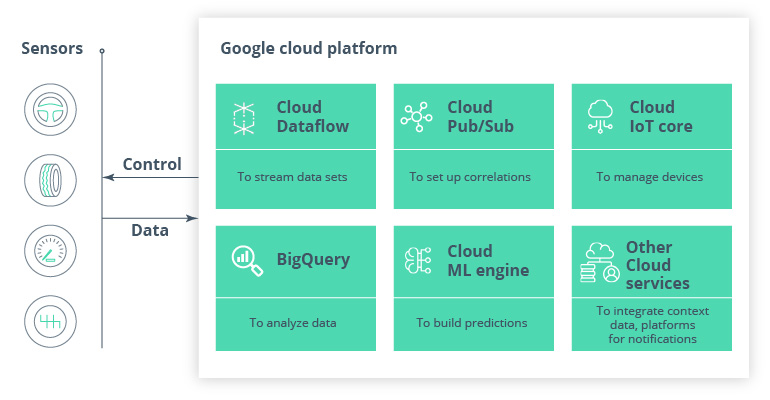Fleet management companies have many expenses, but even seemingly insignificant maintenance issues can start a costly domino effect if not addressed properly and in time. Sometimes, timely detection of an upstream problem such as a turbo failure can prevent more expensive downstream issues, such as an aftertreatment failure.
Waiting a week or two for the next scheduled maintenance kills precious time. Real-time monitoring and data-driven vehicle fleet maintenance software can warn a fleet manager about an entire chain of troubles even a minor problem can cause.
The cost of trucking

The difference between preventive and predictive maintenance all comes down to the technologies behind software for vehicle maintenance. Artificial intelligence (AI) and Internet of Things (IoT) technologies can save fleet companies a fortune on vehicle repairs.
In this article, you’ll find:
- What fleet predictive analytics is
- What is the difference between preventive and predictive software for fleet maintenance?
- Why should you use predictive analytics in fleet management software?
- How does fleet predictive analytics for fleet maintenance work
- Advanced technologies to use for fleet predictive maintenance
- Key benefits of predictive fleet maintenance management system
- Advice to fleet companies on implementing predictive fleet maintenance
What is fleet predictive analytics?
Fleet predictive analytics is used to forecast fleet maintenance based on available fleet management data and past experience. Businesses use fleet predictive analytics to reveal both explicit and implicit dependencies between particular events as well as to identify recurring patterns and trends.
Predictive analytics in fleet management helps to improve both fleet management modeling and the decision-making process. Fleet predictive analytics may rely on diverse types of input data, tools, and approaches. The essential components needed for effective and accurate predictive analytics include:
- historical fleet management data
- statistical analysis methods (standard deviation, Granger causality, hypothesis testing, regression, sample size determination, etc.)
- machine learning and artificial intelligence algorithms
Simply put, historical data serves as the raw material for fleet predictive analytics. In turn, a blend of statistical analysis approaches is used to process the data, while ML- and AI-based solutions help to scale the process, enabling accurate and timely analysis of billions of data points, with no risk of human mistakes.
What is the difference between preventive and predictive software for fleet maintenance?
Fleet managers have a long journey from using preventive vehicle maintenance system that identifies existing problems to using predictive maintenance in automotive software that can detect issues before they manifest. Telematics data, artificial intelligence, and cloud technologies play a growing role in the development of predictive truck fleet maintenance software.
The most illustrative difference between preventive maintenance software for fleets and predictive maintenance is a shift from assumptions and strict scheduling to data-driven decisions and real-time equipment monitoring.
The old-fashioned approach was based on taking a vehicle out of rotation every 3,000 to 4,000 miles or every 10,000 to 12,000 hours for prescheduled and regular maintenance. On the contrary, trucking maintenance software can collect measurements on separate parts of a vehicle that influence maintenance — like oil and tire pressure — to schedule service of equipment only when conditions reach a threshold and most likely will cause problems.

Why should you use predictive analytics in fleet management software?
Software for vehicle maintenance can build predictions based on direct measurements of equipment as well as contextual data like weather conditions, traffic, road quality, and a driver’s behavior. Machine learning in fleet management can be trained on collected data to detect specific failure scenarios, taking into account the condition of separate vehicle parts and the conditions of vehicle exploitation.
Moreover, when integrated with MLOps services, predictive analytics in fleet management software ensures continuous optimization, enabling efficient decision-making for maintenance, route planning, and resource allocation.
Time is the most valuable asset when it comes to detecting potential issues with fleets. It’s pointless to detect a problem minutes before it causes a road incident or cargo damage. More time is needed to act in order to minimize costs and hazards.
This is why predicting equipment issues and planning relevant maintenance becomes so important for fleet management businesses. And predictive vehicle fleet maintenance software can provide alerts on potential issues several days to months in advance.
A smart alert system integrated within fleet maintenance software for trucking can accelerate fleet managers’ and drivers’ reactions in the field. It can also send alerts to make fast decisions on taking a truck off the road, visiting a nearby repair shop, or finishing the route and addressing the issue upon the vehicle’s return.
How does predictive analytics for fleet maintenance work?
Tech-driven fleet maintenance is powered by decisions fueled with telematics data. The combination of large volumes of fleet management data captured with IoT devices and advanced machine learning for fleet management enable businesses to proactively identify fleet issues.
Using fleet predictive analytics software, managers can identify trends, forecast problems before they occur, and ensure that the fleet is managed sustainably. Simply put, the work of fleet predictive analytics can be divided into three major phases:
- Data collection. IoT devices capture telematics data.
- Data transmission. Collected data is shared with fleet management analytics software in real time and in buckets.
- Data processing and analysis. AI in fleet management analyzes data volumes to reveal both explicit and implicit dependencies between events. Afterward, predictions and analytical insights are generated and delivered to a manager via the fleet management solution’s interface.
Let’s take route optimization as an example. A route optimization system puts together and analyzes both current and historical traffic data along with GPS information and logistics schedules. Then, it generates the most efficient route.
While processing the data, an algorithm scores the likelihood of a particular event, such as traffic, a delay, or an accident. These predictions are then taken into account to generate an optimal route.
To process data analytics and deliver fast alerts, advanced predictive vehicle maintenance systems usually rely on cloud computing power and a flexible microservices architecture to integrate additional services for contextual data on things like weather and traffic. In the end, service and fleet managers receive easy-to-use reports with all the tools needed to plan relevant equipment maintenance.
What advanced technologies are behind predictive fleet maintenance?

Let’s take a look on how artificial intelligence impacts fleet management. AI plays a critical role in building predictions based on collected telematics data. To process data analytics and deliver fast alerts, predictive vehicle maintenance system should rely on cloud computing power and a flexible microservices architecture to integrate additional services for contextual data on things like weather and traffic. Finally, service and fleet managers should receive easy-to-use reports and have all the tools at hand to plan relevant equipment maintenance.
Telematics data collection
By turning to telematics data, fleet companies can shift from reactive to preventive measures. Doing so helps them address small problems before they become big. Connected IoT sensors can provide real-time data on vehicle parts and send Diagnostic Trouble Codes (DTCs) to track mechanical failures in real time while fleet maintenance management system uses this data for analytics and predictive maintenance planning.
Flexible cloud architecture
Taking into account the amount of data from the many sensors and vehicles, trucking maintenance software requires a flexible architecture that allows for easy integration of third-party services for additional contextual data. Cloud computing power allows for processing big data sets and provides access to critical data from everywhere while allowing businesses to shift to customer-oriented SaaS business models.
Example of a predictive vehicle fleet maintenance software built on Google Cloud Platform

AI and machine learning algorithms
Service managers and fleet companies can use telematics data beyond DTC information to ensure smart analytics of all historical and collected data points on separate vehicle parts. Diving deeper into the data using ai for fleet maintenance software, sensor fusion algorithms for autonomous driving, fleet companies can detect early warning signs of potential equipment failure.
Simply gathering all the data coming from sensors is not enough. Making effective machine learning predictions for fleet maintenance requires you to follow a certain flow:
- Set up health conditions and automotive quality control techniques for each vehicle part based on historical data to train the machine learning model to recognize abnormalities.
- Ensure an uninterrupted flow of recent data to the machine learning engine to monitor equipment health in real time and train the model to detect deviations.
- Integrate the machine learning engine with notification systems to alert service managers of warning signs so they can plan maintenance or immediately take a vehicle off the road.
So, how artificial intelligence impacts fleet management? For electric trucks, for example, predictive maintenance software can regularly check the battery status, transfer data to the cloud, apply AI models to predict how a vehicle will consume energy under the current conditions, and notify the driver to avoid issues like a dead battery as well as to plan maintenance when the battery’s capacity goes lower than what’s specified by the OEM.
User-friendly and comprehensive dashboards
When running AI data analytics for failure prediction, truck fleet maintenance software should provide a visual representation of data in a consumable form. The best way to do this is to offer dashboards with customizable functionality so fleet managers can choose what data is the most critical to show. Cross-platform accessibility ensures fleet managers are always connected and can react to potential issues, monitoring fleets from mobile devices.
Key benefits of predictive fleet management maintenance software
Apart from business-critical benefits such as reduced costs on fleet repairs, a predictive vehicle maintenance system can deliver value for companies by optimizing vehicle utilization and even improving driver satisfaction. Predictive maintenance solutions allow fleet managers to automate some routine tasks and share responsibilities with regular operators who respond to alerts, while managers can focus on other work. Workflows automation offered by fleet maintenance management system saves time on tracking issues, eliminates the risk of human error, and minimizes meaningless but costly servicing before it’s really needed since maintenance is based on actual utilization and measurements instead of time intervals and assumptions.
Reduced downtime and increased vehicle availability
The first way predictive trucking maintenance software helps fleets is by reducing vehicle downtime due to avoidable repairs. In addition, vehicles can be utilized more efficiently because maintenance is planned only when it’s required. When planned based on random dates or mileage, vehicle maintenance steals time by making equipment unavailable for use. With predictive maintenance, fleet managers can schedule maintenance based on accurate diagnostics and vehicle usage information. As vehicles with less use do not require as many maintenance stops, the availability of assets increases while losses due to unnecessary maintenance are minimized.
Increased efficiency of fleets and drivers
Using ai for fleet maintenance software as well as applying other advanced technologies to fleet management can improve the entire repair network. Continuously monitoring each vehicle results in individual vehicle profiles, which makes it easier for technicians to perform repairs and take preventive measures to avoid related issues. As a result, fleets avoid losing their equipment for extended periods to detect all malfunctions while drivers avoid incidents on the road.
Fuel economy and smart resource planning
Fuel is the second biggest expense in the trucking business. And proper maintenance can save fuel. For example, by monitoring the pressure of the inlet and outlet can increase air throughput of the filters and their cleanness. By combining AI and fleet management, you can detect differences in pressure because of regen, which happens more often when the filter is clogged as ash and soot are not burning with fuel. In such a way, the system can show when a diesel filter should be replaced even before the monitoring system sends a DTC.
Advice to fleet companies on the way to predictive fleet maintenance
All the data collected from connected fleets can be overwhelming for fleet managers. There are 17,000 fault codes that can be broadcast over the J1939 connector and each one could indicate up to 25 different failure modes. AI stitches together all the data points from disparate sources to create actionable insights.
As you can see, using ai for fleet maintenance software can take the burden of data analytics and data-driven insights to improve fleet efficiency, simplify processes for fleet workers, and save businesses from burning huge sums on repairs. Here’s some advice on how to evolve outdated fleet preventive maintenance software to predictive vehicle maintenance system.
- Reverse the legacy culture – Instead of repairing a truck when it breaks, fix a potentially weak link in advance.
- Invest in proven tools or develop your own – Connected sensors installed on vehicle hardware are good, but integration with software tools is better.
- Don’t miss any data – Collect data on equipment and its context to cover the entire lifecycle of a vehicle that impacts its maintenance.
- Monitor, measure, act – Establishing thresholds of use for each asset and monitoring how close a vehicle gets to those thresholds makes outcomes more predictable and enables timely actions.
Applying advanced technologies to fleet maintenance to predict potential issues is a bold task to undertake on your own. Partnering with a software development vendor with expertise in fleet management solutions will help you save time and money on the development of your product and eliminate possible AI in autonomous driving challenges.
Contact Intellias to rapidly apply recent technologies to your fleet management solution.




